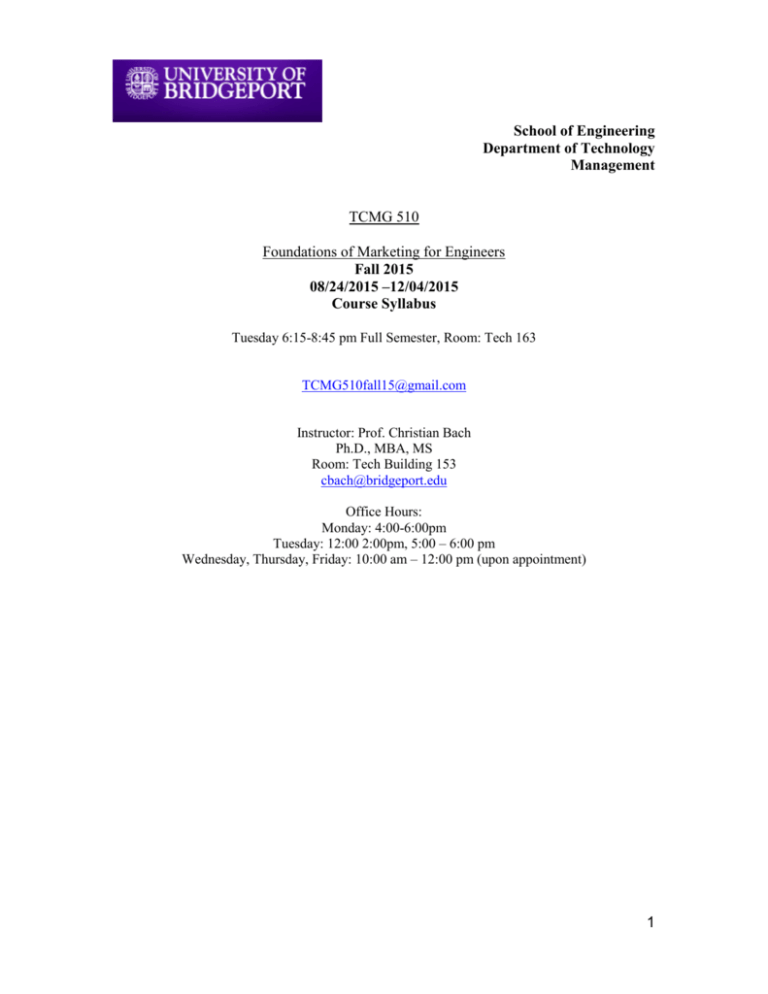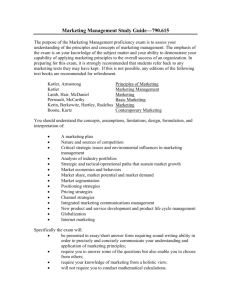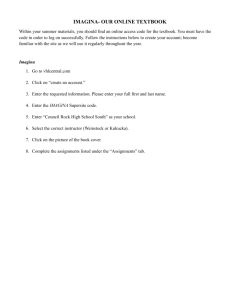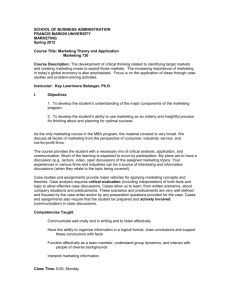TCMG 510 - University of Bridgeport
advertisement

School of Engineering Department of Technology Management TCMG 510 Foundations of Marketing for Engineers Fall 2015 08/24/2015 –12/04/2015 Course Syllabus Tuesday 6:15-8:45 pm Full Semester, Room: Tech 163 TCMG510fall15@gmail.com Instructor: Prof. Christian Bach Ph.D., MBA, MS Room: Tech Building 153 cbach@bridgeport.edu Office Hours: Monday: 4:00-6:00pm Tuesday: 12:00 2:00pm, 5:00 – 6:00 pm Wednesday, Thursday, Friday: 10:00 am – 12:00 pm (upon appointment) 1 ________________________________________________________________________________________ Course Description & Approach This course is a pragmatic course focused on contemporary marketing and innovation issues, opportunities and current and emerging industry best practices in helping technology oriented and engineering organizations grow and achieve sustainable competitive advantages in a complex and rapidly changing global environment. The impact of new technologies, which enable and provide strategic marketing and innovation will also be covered. The course will provide an opportunity to identify and analyze business, technology and marketing issues and opportunities through a combination of lectures, case studies, term projects, and review of current events, experiential exercises, term paper and class participation. It includes a structured approach for preparing students for academic research and publication writing. Course Learning Objectives Understand the growing role and importance of strategic marketing and innovation in the continued growth and success of small and large technology organizations and how to more effectively integrate these components into a business Define and analyze different marketing and strategies (including planning, segmentation, positioning, distribution, websites, products, partnerships, customer, etc.) and learn how to capitalize on them and focus on developing value added products and services Understand the impact of a broad set of technologies on the transformation of organizations into more flexible, leaner, nimbler and effective entities through e-Marketing, social Media, the Internet, Knowledge Management, New Product Innovation, CRM, etc. Review the tools, processes, techniques and competencies required to be effective marketers, entrepreneurs, innovators and change agents Complete a detailed marketing plan for a new product or service or business or an extension of an existing product or business Cases, Team Project and Final Paper Required Text: Mohr, J.J., S. Sengupta, and S. Slater, Marketing of High-Technology Products and Innovations (3rd Edition) 2010, New York: Prentice Hall. (Mohr, Sengupta, & Slater, 2010). ISBN-10: 0136049966 ISBN-13: 978-0136049968. Additional Text (optional): Kotler, P., & Keller, K. (2012). Marketing Management (14th Edition), ISBN-13: 978-0132102926, ISBN10: 0132102927. New Jersey: Prentice Hall. (Kotler & Keller, 2012) Malerba, F., & Brusoni, S. (2007). Perspectives on Innovation: Cambridge University Press. ISBN-10: 0521866642, ISBN-13: 978-0521866644. Additional handouts will be provided in class. The handouts must be brought to the class for the first class and all subsequent class sessions. Course Requirements 1. Class Attendance, Participation, Punctuality, Cheating and Plagiarism: Timely attendance at each class session is mandatory. Class lectures complement, but do not duplicate textbook information. Together students and instructor will create an interactive learning environment. A significant portion of your learning will accrue through the constructive and respectful exchange of ideas and search for alternative solutions. You must be actively engaged in class discussions to improve your thinking and communication skills. 2 It is the student's responsibility to become familiarized with and adhere to the standards set forth in the policies on cheating and plagiarism as defined in Chapters 2 and 5 of the “Key to UB Student Handbook” available at http://www.bridgeport.edu/pages/2623.asp or the appropriate graduate program handbook. As a UB policy, it is expected that each student that attends one hour of classroom instruction will require a minimum of two hours of out of class student work each week for approximately fifteen weeks for one semester. 2. Preparation, Deadlines and Late Policy: Late assignments will be penalized 20% for each class day past the deadline. No excuses will be accepted. Don’t wait until the last minute to print out your assignment. Email late homework assignments to assigned email account. PhD students will receive additional research assignments. 3. Homework/Case Analysis The syllabus identifies the oral and written homework assignments. Each written assignment must be typed and only one or two pages long. Late submissions have 20% penalty per day. All students are required to read and submit seven (7) written cases and one (1) paper. Students must be prepared to discuss all cases in class. Each case homework should be 1-2 pages long and must include: 4. Current Events/ News Each student will be required to bring in and orally review news articles relating to the topic assigned for the class meeting. These will be orally summarized by the students in class and collected by the instructor. Suggested sources include: Wall Street Journal, New York Times, Business Week, The Economist, Harvard Business Review, Sloan Management Review, Newsweek, Time, Fortune, Forbes, Financial Times, American Marketing Association Journal, the Journal of New Product Development, Fast Company and other relevant sources. 5. Team Term Project and Presentation Marketing Plan In the first session; 8 teams (2-4 members) will be formed. Each team will prepare a written marketing plan (6 - 8 pages, double space, 12 point, Times New Roman). The Team must properly use and cite intext 5 - 10 academic articles from academic journals and list the references at the end of the paper in mandatory APA style. The team can use articles that have been distributed by the instructor. The team will present the Marketing Plan to the class. All sources (pages from articles, books, web pages, etc.), used for the paper, must be turned into pdf and emailed together with the project – make sure that you cite the sources in the text with page number of the paper and reference them at the end of the paper in APA style. Two presentations are required for this project. Based on the feedback from the instructor and the class participants on the first presentation (Part 1), the final presentation (Part 2) may propose a totally different marketing/business plan from the one originally presented in Part 1, or may simply revise the material presented in the first presentation. Part 1: (the first presentation) must address Items 2 – 8, 12 Part 2: (the final presentation) must cover all of the Items 1-12 listed below: All recommendations and assumptions must be supported by facts (referred journal articles) that are clearly referenced. A detailed outline is provided in the Marketing Plan. Required sections of the Marketing Plan for a Technology Product, Service or Company: 3 1.) Executive Summary 2.) Company Vision and Objectives 3.) Current Market Situation: Product or Service Objectives, Description (functions, features) and Value Proposition (Benefits to the Buyer) 4.) Current Market Situation: Major Industry Characteristics, Trends, Regulations, etc. 5.) Current Market Situation: Market Opportunity and Segments (Who is the Targeted Customer? What is the size of the market? Explain how the market will grow. 6.) Current Market Situation: Competition – Identify the major competitors and their key attributes 7.) Barriers to Entry (what you do to make it difficult for competitors to enter the market in your space) 8.) Major Risks and Contingencies and SWOT Analysis 9.) Marketing Plan – market share, gross margins, marketing strategies and imperatives such as market segments, pre-launch, post- launch, positioning, distribution channels, pricing, branding, advertising and promotion, customer retention and loyalty programs, marketing metrics and key performance indicators, etc. 10.) References (APA style) To receive a high grade, every member of the team must equally participate in presentations, its preparation and delivery. 6. Written Term Paper & Suggested Topics Each student will prepare a written academic report (3000 – 4000+ words (14-16 pages double-spaced), 12 point, Times New Roman) on a marketing topic, or topic related to the course. Students collect 5 academic journal articles on the topic of their choice and write a report on the authors’ empirical findings and opinions about the topic and use real world cases (e.g. from Armstrong/Kotler textbook) to discuss the selected factors and concepts (usefulness, pro/cons, etc.) while stating their own opinions, arguments, recommendations and conclusion. An executive summary will be presented to class using 1-3 Posters. You may select from the suggested topics listed in the syllabus, or submit your own topic for approval. The paper must be well written, typed and page numbered, be supported by research containing refereed references and be consistent with general expectations of graduate study. You can use articles that have been distributed by the instructor. All sources (pages from articles, books, web pages, etc.) you are using for the paper must be cited in-text including page numbers and be references at the end of the paper in APA style. Course Grading Class participation, News & Attendance Team Project Homework/Academic Assignments Midterm Exam Final Exam Written Term Paper and Oral Summary 10 % 30 % 10 % 10 % 10 % 30 % 100 % Course Structure Lecturing is only one of the three approaches used in this course. Knowledge will be acquired through facilitated case/article discussions and student presentations. Students are expected to engage actively in preparing for and presenting the case materials. For completing the assignments and project, students may need to do additional research, and look for information and knowledge that is not covered by the textbook and the lectures. It is assumed that a major learning objective for this course is to cultivate students’ capability in searching, identifying, evaluating, and integrating relevant knowledge that may or may not be provided in the class. 4 Schedule & Assignments Note: this is a working outline, and may be revised to meet the needs of class participants. Date Topics and Assignments Reading Marketing of High-Technology Course Overview Session#1 Formation of Teams (2-3 members): Session #2 Introduction to the World of High-Technology Marketing Read Book: Strategic Market Planning In High Tech Firms - Chapters1,2 Book: Ch1 and Ch2 (Mohr et al., 2010) Case1 and Homework: High-Tech Marketing; (additional material) Moriarty, R. T., & Thomas, J. K. (1989). High-Tech Marketing: Concepts, Continuity, and Change. [Article]. Sloan Management Review, 30(4), 7-17. (Moriarty & Thomas, 1989) Each student is prepared to comment on an important issue using the textbook. Session #3 Culture and Climate Considerations for High-Tech Companies Market Orientation and Cross-Functional (Marketing/R&D) Interaction Book: Ch3 and Ch4 (Mohr et al., 2010) Case2 and Homework: The Profitless PC Blackburn, A., Halprin, M., & Veloria, R. (1998). The Case Of The Profitless PC Harvard Business Review, 76(6), 28-32. (Blackburn, Halprin, & Veloria, 1998), (additional material) Read Book: - Chapters3,4 Each student is prepared to comment on an important issue using the textbook. Session #4 Relationship Marketing: Partnerships and Alliances Marketing Research in High-Tech Markets Book: Ch5 and Ch6 (Mohr et al., 2010) Case3 and Homework: Sieble Systems, Stanford Case, 1999; (additional material) Read Book: - Chapters5,6 Each student is prepared to comment on an important issue using the textbook. Session #5 Understanding High-Tech Customers Technology and Product Management Book: Ch7 and Ch8 (Mohr et al., 2010) Case4 and Homework: WebCollage: Penetrating New Markets, Columbia Business School Case, 2004; (additional material) Read Book: - Chapter7,8 Tech-Marketing Plan Each student is prepared to comment on an important issue using the textbook. Session #6 Creating Brand Equity Crafting the Brand Position Book: Ch9,10 (Kotler & Keller, 2012) Case5 and Homework: Biopure Corp, HBS Case, 1999; (additional material) ___________________________________________________________ Read Book: - Chapter9,10 Mid-term Exam ___________________________________________________________ Team Project Topic Presentation: (optional) 2.) Company Vision and Objectives 3.) Current Market Situation: Product or Service Objectives, Description (functions, features) and Value Proposition (Benefits to the Buyer) 9.) SWOT Analysis Each student is prepared to comment on an important issue using the textbook. Session #7 Competitive Dynamics Setting Product Strategy Book: Ch11,12 (Kotler & Keller, 2012) Case6 and Homework: Versioning: The Smart Way to Sell Information, HBR, 1998, 106-114; (additional material) Read Book: - Chapter11,12 Each student is prepared to comment on an important issue using the textbook. Session #8 Designing and Managing Services Developing Pricing Strategies and Programs Book: Ch13,14 (Kotler & Keller, 2012) Case7 and Homework: Celera Genomics and Biotech Business Model; Read Book: - Chapter13,14 5 (additional material) Each student is prepared to comment on an important issue using the textbook. Session #9 Session #10 Session #11 Session #12 Due: Individual Presentations Email/Submit: electronic copy of Individual Paper and Poster Designing and Managing Integrated Marketing Managing Retailing, Wholesaling, and Logistics Book: Ch15,126 (Kotler & Keller, 2012) Case8: Don’t let the sun get under your skin: Targeting adolescent sun protection with a novel social marketing campaign p. 326; Exercise1: Seven Useful Theories p. 55, (additional material) Designing and Managing Integrated Marketing Communications Managing Mass Communications: Advertising, Sales Promotions, Events and Experiences, and Public Relations Book: Ch17,18 (Kotler & Keller, 2012) Case9: A case of critical thinking: Marketing strategies used to promote licensed drugs p. 361; (additional material) Exercise2: A failed norms social marketing campaign p. 64 Innovation Introduction: The Discipline of Innovation Book: (Malerba & Brusoni, 2007) ch11: Schumpeterian legacies for entrepreneurship and networks: the social dimension of entrepreneurial aciton Read Book: Chapter 15, 16 Read Book: Chapter 17, 18 Read Book: Chapter 11 Team Preparations: Team1: Drucker (2000) ,Team2: Hamel (2006), Team3: Hansen (2007), Team4: Pisano (2008); (additional material) Session #13 Team Project Presentation: Marketing/Business Plan Presentation (must cover items 2 - 8 of section 6 in syllabus) Introduction: The Value Chain of Innovation Book: (Malerba & Brusoni, 2007) ch12: Knowledge-based entrepreneurship: the organizational side of technology commercialization Read Book: Chapter 12 Team Preparations: Team5: Bettencourt (2008), Team6: Kim (2004), Team7: Scott (2006), Team8: Pugh (2008); (additional material) Session #14 Due: Final Paper Presentation / Guest Speaker Session #15 Final Exam 6



